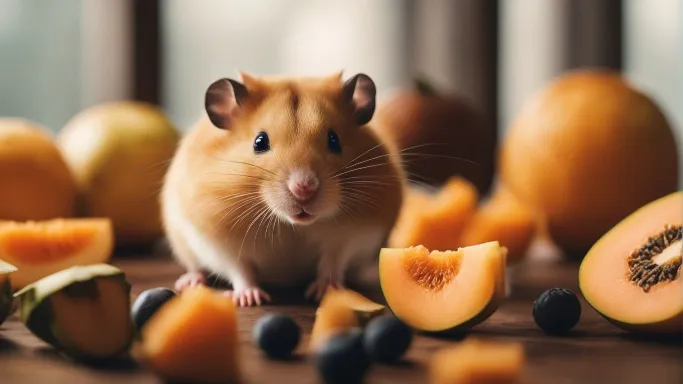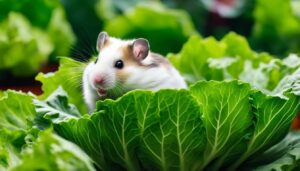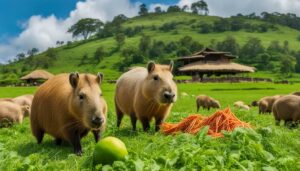If you’re wondering whether your hamster can enjoy the deliciousness of cantaloupe, you’re in the right place.
Cantaloupe can be a tasty and nutritious addition to your furry friend’s diet, but there are some important factors to consider before offering this fruit to them.
Key Takeaways:
- Hamsters can eat cantaloupe in moderation.
- Cantaloupe is low in calories and high in vitamins A and C, potassium, and fiber.
- Feed hamsters small quantities of cantaloupe, about the size of their thumb, once or twice a week.
- Do not feed hamsters cantaloupe seeds or skin, as they can cause injury and may contain harmful chemicals.
- Other fruits that can be safely fed to hamsters include apples, carrots, blueberries, grapes, mango, papaya, peas, raspberries, spinach, sweet potato, and strawberries.
Nutritional Benefits of Cantaloupe for Hamsters
Cantaloupe not only appeals to our taste buds, but it also packs quite a nutritional punch for our little furry friends. Hamsters can enjoy the benefits of this delicious fruit, as it is low in calories and high in essential vitamins and minerals. Rich in vitamins A and C, cantaloupe can help support a hamster’s immune system, keeping them healthy and strong. The fruit is also a good source of potassium, which is important for maintaining proper heart and muscle function. In addition, cantaloupe provides fiber, promoting good digestion and preventing constipation.
To ensure your hamster receives the nutritional benefits of cantaloupe without any negative side effects, it is important to feed it in moderation. Offer small quantities – about the size of your hamster’s thumb – once or twice a week. This will provide a tasty treat while ensuring a balanced diet. Remember, moderation is key!
| Nutrient | Amount per 100g |
|---|---|
| Vitamin A | 3382 IU |
| Vitamin C | 36.7 mg |
| Potassium | 267 mg |
| Fiber | 0.9 g |
It is important to note that while cantaloupe is a wonderful snack for hamsters, the seeds and skin should not be fed to them. These parts can cause injury and may contain harmful chemicals. Always remove the seeds and skin before offering cantaloupe to your furry companion.
Alongside cantaloupe, there are other fruits that can be safely incorporated into a hamster’s diet. Apples, carrots, blueberries, grapes, mango, papaya, peas, raspberries, spinach, sweet potato, and strawberries are all hamster-friendly options. Introducing a variety of fruits into your hamster’s diet will ensure they receive a range of nutrients and flavors.
Remember, when introducing new foods to your hamster, including cantaloupe, it is best to do so gradually. This will help minimize any digestive issues or potential allergies. Offer small portions and observe how your hamster reacts. If there are no adverse reactions, you can continue to include cantaloupe in their diet, providing them with a delicious and nutritious treat.
Moderation is Key: How Much Cantaloupe Should Hamsters Eat?
While cantaloupe has its nutritional benefits, it’s crucial to remember that moderation is key for your hamster’s overall well-being. Cantaloupe can be a healthy and delicious treat for your furry friend, but too much of it can lead to digestive issues and other health concerns. Therefore, it’s important to feed cantaloupe to hamsters in small quantities and only as an occasional addition to their diet.
Experts recommend offering cantaloupe to hamsters once or twice a week, in portions about the size of the hamster’s thumb. This ensures that they receive the nutritional benefits of the fruit without overloading their digestive system. It’s best to introduce cantaloupe gradually, starting with a small piece and observing how your hamster reacts to it. If there are no adverse effects, you can continue to include cantaloupe as part of their varied diet.
When serving cantaloupe to your hamster, it’s crucial to remove the seeds and skin. Cantaloupe seeds can pose a choking hazard, and the skin is difficult for hamsters to digest. Additionally, the skin and seeds may contain harmful chemicals or pesticides. By removing these parts, you can minimize the risk of injury or illness to your hamster.
| Fruits Safe for Hamsters | Feeding Guidelines |
|---|---|
| Apples | Remove seeds and core, serve in small slices |
| Carrots | Wash, peel, and cut into small pieces |
| Blueberries | Offer as a small handful, rinse before serving |
| Grapes | Cut into small pieces, remove seeds |
| Mango | Peel and cut into small cubes |
“A balanced diet is essential for the health and well-being of hamsters. In addition to cantaloupe, you can also offer a variety of other fruits to provide essential nutrients. Just remember to introduce new foods gradually, monitor your hamster’s reaction, and ensure that the fruits are safe for their consumption.”
In addition to cantaloupe, there are many other fruits that can be safely fed to hamsters. Apples, carrots, blueberries, grapes, mango, papaya, peas, raspberries, spinach, sweet potato, and strawberries are all excellent choices that can provide your hamster with a well-rounded diet. However, it’s important to remember that fruits should be offered in moderation and as part of a balanced diet that includes hamster-specific pellets, fresh vegetables, and clean water.
By following these guidelines and offering a diverse range of fruits and vegetables, you can ensure that your hamster receives the necessary nutrients without overindulging in any one food. Remember, just like humans, hamsters thrive on a balanced and varied diet that supports their overall health and well-being.
| Hamster Diet: Guidelines and Best Practices | |
|---|---|
| 1. Pellets: | Provide a high-quality, hamster-specific pellet food as the main component of their diet. |
| 2. Fresh Vegetables: | Offer a variety of fresh, washed vegetables daily. |
| 3. Fruits: | Include small portions of hamster-safe fruits, such as cantaloupe, once or twice a week. |
| 4. Clean Water: | Ensure your hamster always has access to fresh, clean water. |
| 5. Dental Health: | Provide chew toys or blocks to promote dental health and prevent overgrown teeth. |
Potential Risks of Excessive Cantaloupe Consumption
Although cantaloupe has its advantages, it’s essential to be aware of the potential risks associated with overindulging your hamster in this juicy fruit. While cantaloupe is generally safe for hamsters to consume in moderation, excessive intake can lead to digestive problems and other health concerns.
One of the main risks of feeding too much cantaloupe to your hamster is the high sugar content. Cantaloupe is naturally sweet, and consuming too much sugar can disrupt a hamster’s delicate digestive system. This can result in diarrhea, bloating, and discomfort for your furry friend. It’s important to remember that hamsters have small bodies and relatively low caloric needs, so excess sugar can easily throw off their diet and lead to weight gain.
Another risk associated with excessive cantaloupe consumption is the potential for choking hazards. The seeds and skin of cantaloupe should never be fed to hamsters, as they can cause injury and contain harmful chemicals. Always remove the seeds and skin before offering cantaloupe to your hamster to ensure their safety and well-being.
To prevent these risks, it’s crucial to feed cantaloupe to your hamster in small quantities and as an occasional treat. A good rule of thumb is to offer a piece of cantaloupe that is about the size of your hamster’s thumb once or twice a week. This way, your hamster can enjoy the nutritional benefits of cantaloupe without putting their health at risk.
| Risks of Excessive Cantaloupe Consumption | Prevention Strategies |
|---|---|
| Digestive problems and bloating | Feed cantaloupe in moderation and remove seeds and skin before offering it to your hamster. |
| Choking hazards | Avoid feeding cantaloupe seeds and skin to your hamster. |
| Weight gain | Limit the frequency and quantity of cantaloupe given to your hamster. |
It’s important to remember that every hamster is different, and what works for one may not work for another. If you notice any signs of discomfort or digestive issues after feeding your hamster cantaloupe, it’s best to consult with a veterinarian for further guidance.
Cantaloupe Preparation for Hamsters
Before serving cantaloupe to your hamster, it’s essential to take a few important steps to ensure its safety and suitability as a hamster-friendly treat. Follow these guidelines to properly prepare cantaloupe for your beloved pet:
- Remove the seeds: Cantaloupe seeds can be a choking hazard and are not suitable for hamsters to consume. Carefully scoop out the seeds from the center of the fruit using a spoon or melon baller.
- Remove the skin: The tough outer skin of the cantaloupe should also be removed before feeding it to your hamster. Peel off the skin using a knife or vegetable peeler, ensuring that no remnants are left behind.
- Cut into small pieces: Once the seeds and skin have been removed, cut the cantaloupe into small, bite-sized pieces. This will make it easier for your hamster to eat and minimize the risk of choking.
“Cantaloupe provides a refreshing and nutritious treat for hamsters, but it’s important to prepare it correctly to ensure your pet’s safety and enjoyment,” says Dr. Jane Robinson, a veterinarian specializing in small animals.
While cantaloupe can be a great source of vitamins and minerals for hamsters, it should be fed in moderation and as part of a balanced diet. Remember to always monitor your hamster’s reactions to new foods and consult with a veterinarian if you have any concerns.”
Hamster-Friendly Fruit Comparison:
| Fruit | Nutritional Benefits | Serving Frequency |
|---|---|---|
| Cantaloupe | High in vitamins A and C, potassium, and fiber | Once or twice a week, small quantities |
| Apple | Rich in fiber and vitamin C | Occasionally, remove seeds and core |
| Carrot | Good source of vitamin A and fiber | 2-3 times a week, small pieces |
| Blueberries | High in antioxidants and vitamin C | Once a week, a few berries |
Remember, variety is key when it comes to your hamster’s diet. In addition to cantaloupe, you can offer other fruits like apples, carrots, blueberries, grapes, mango, papaya, peas, raspberries, spinach, sweet potato, and strawberries. These fruits provide a range of essential nutrients that can contribute to your hamster’s overall health and well-being.
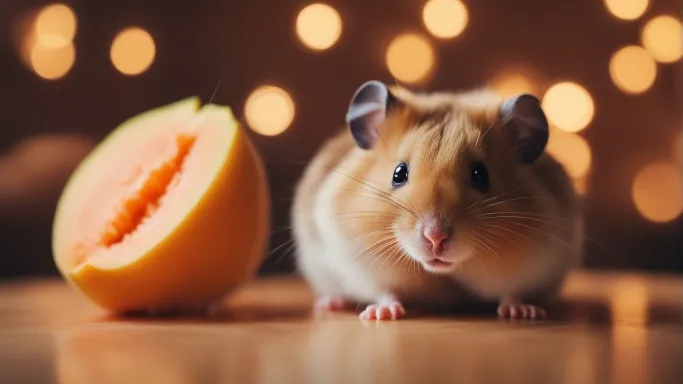
Other Fruits Suitable for Hamsters
Cantaloupe isn’t the only fruit that can add variety and nutrition to your hamster’s diet. Hamsters can enjoy a wide range of fruits, each offering its own unique benefits. Incorporating these hamster-friendly fruits can help keep your furry friend happy and healthy. Here are some fruits to consider:
| Fruit | Benefits |
|---|---|
| Apples | High in fiber and vitamin C |
| Carrots | Rich in vitamin A and provide a satisfying crunch |
| Blueberries | Packed with antioxidants and vitamin C |
| Grapes | Contain hydration and natural sugars |
| Mango | Provides vitamin A and a tropical twist |
| Papaya | Offers digestive enzymes and vitamin C |
| Peas | Rich in protein and vitamins B and K |
| Raspberries | High in fiber and antioxidants |
| Spinach | Provides iron and other essential nutrients |
| Sweet Potato | Loaded with vitamin A and beta-carotene |
| Strawberries | Contain vitamin C and natural sweetness |
When introducing these fruits to your hamster’s diet, it’s important to remember a few key points. Firstly, always wash the fruits thoroughly to remove any pesticides or harmful residues.
Secondly, start with small portions and gradually increase the amount to allow your hamster’s digestive system to adjust.
Observe your hamster for any signs of sensitivity or allergies when introducing new foods.
Remember, while fruits are a healthy addition to a hamster’s diet, they should be offered in moderation.
The primary food source for hamsters should still be a high-quality hamster pellet or mix to ensure they receive all the necessary nutrients. A balanced diet is essential for their well-being.
By incorporating a variety of hamster-friendly fruits and carefully monitoring their intake, you can provide your furry friend with a diverse and nutritious diet.
Give them the opportunity to enjoy different flavors and textures while keeping their health in mind.
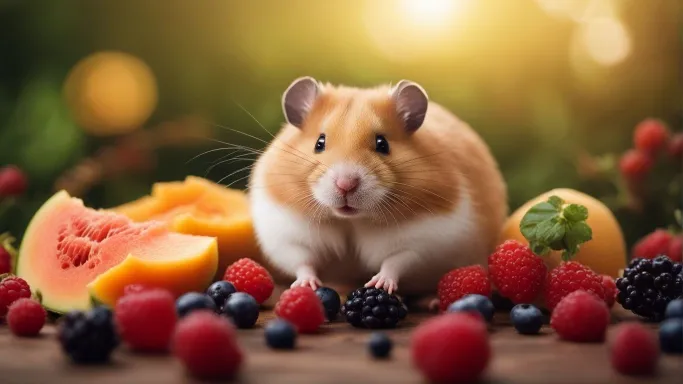
Introducing New Foods to Your Hamster
When it comes to incorporating new foods into your hamster’s diet, a slow and cautious approach is highly recommended.
This is particularly important when introducing fruits, such as cantaloupe, to your furry friend. While cantaloupe can offer nutritional benefits to hamsters, it is crucial to ensure their safety and well-being by following some simple guidelines.
Firstly, it is essential to remember that hamsters have sensitive digestive systems. Introduce cantaloupe gradually, starting with small pieces about the size of your hamster’s thumb.
This will allow their bodies to adjust to the new food and prevent any potential digestive upset.
In addition to cantaloupe, there are several other hamster-friendly fruits that you can incorporate into their diet.
These include apples, carrots, blueberries, grapes, mango, papaya, peas, raspberries, spinach, sweet potato, and strawberries.
Adding variety to their diet ensures they receive a range of nutrients and flavors, keeping them happy and healthy.
Remember, when offering fruits to your hamster, always remove any seeds, pits, or skins. These parts can be harmful to your hamster’s health and may cause choking or digestive issues.
By following these guidelines and introducing new foods gradually, you can provide your hamster with a nutritious and varied diet, promoting their overall well-being.
| Hamster-Friendly Fruits |
|---|
| Apples |
| Carrots |
| Blueberries |
| Grapes |
| Mango |
| Papaya |
| Peas |
| Raspberries |
| Spinach |
| Sweet Potato |
| Strawberries |
Providing a Balanced Diet for Hamsters
A healthy and well-rounded diet is essential for your hamster’s overall health and longevity. In addition to their staple diet of hamster pellets, incorporating a variety of hamster-friendly fruits can provide important nutrients and enrich their diet.
Cantaloupe, in moderation, can be a delicious and nutritious addition to your hamster’s menu. It is low in calories, high in vitamins A and C, and a good source of potassium and fiber.
When feeding cantaloupe to your hamster, it is important to exercise portion control. Offering small quantities of cantaloupe, about the size of your hamster’s thumb, once or twice a week is sufficient.

This ensures that they receive the benefits without overloading their system. Remember to remove the seeds and skin before feeding, as they can pose a choking hazard and contain harmful chemicals.
While cantaloupe is a great option, it is also important to vary your hamster’s fruit intake. Apples, carrots, blueberries, grapes, mango, papaya, peas, raspberries, spinach, sweet potato, and strawberries are all safe and nutritious choices.
Including a mix of these fruits in their diet can provide a wider range of vitamins, minerals, and flavors.
When introducing new foods to your hamster’s diet, including cantaloupe, it is best to do so gradually.
This allows your hamster’s digestive system to adjust and minimizes the risk of upset stomachs or potential allergies.
Offer a small amount of the new food alongside their regular diet and observe how they respond. If there are no adverse reactions, you can gradually increase the quantity over time.
| Fruit | Benefits |
|---|---|
| Apples | High in fiber and vitamin C |
| Carrots | Rich in beta-carotene and a good source of fiber |
| Blueberries | Packed with antioxidants and vitamin C |
| Grapes | Contain water and natural sugars for hydration and energy |
| Mango | Rich in vitamins A and C, and a source of fiber |
| Papaya | Contains enzymes that aid digestion |
Remember, while fruits can provide vital nutrients, they should be offered as a supplement to a balanced hamster diet, which includes a mix of hamster pellets, fresh vegetables, and occasional protein sources.
Regularly monitoring your hamster’s food intake and consulting with a veterinarian can help ensure that their diet meets their specific nutritional needs.
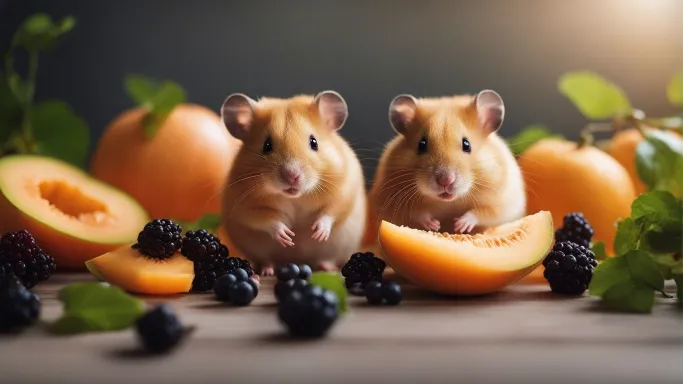
Hamster Diet: Guidelines and Best Practices
Feeding your hamster a nutritionally balanced diet is crucial to support their well-being and promote a long and happy life.
When it comes to introducing fruits into your hamster’s diet, cantaloupe can be a tasty and nutritious option.
However, it’s important to remember that moderation is key. Cantaloupe should only be offered as an occasional treat, not as a staple food.
To ensure a balanced diet for your hamster, you should provide a variety of fruits, vegetables, and high-quality hamster pellets.
While cantaloupe is safe for hamsters to eat, it should be given in small quantities, about the size of your hamster’s thumb, once or twice a week.
This will prevent overconsumption and minimize the risk of digestive problems.
When offering cantaloupe to your hamster, it’s important to remove the seeds and skin. Cantaloupe seeds can be a choking hazard and the skin may contain harmful chemicals.
By preparing the cantaloupe properly, you can ensure that it is safe for your furry friend to enjoy.
Other fruits that are safe for hamsters include:
- Apples
- Carrots
- Blueberries
- Grapes
- Mango
- Papaya
- Peas
- Raspberries
- Spinach
- Sweet potato
- Strawberries
Remember to introduce new foods gradually to your hamster’s diet to minimize any potential digestive issues or allergies. It’s also important to provide fresh water at all times and to regularly clean your hamster’s food bowl to prevent contamination. By following these guidelines and best practices, you can ensure that your hamster receives a well-rounded and nutritious diet.
| Benefits of Cantaloupe for Hamsters | Risks of Excessive Cantaloupe Consumption |
|---|---|
| – Low in calories | – Digestive problems |
| – High in vitamins A and C | – Potential health concerns |
| – Good source of potassium and fiber |
Conclusion
Cantaloupe can be a nutritious addition to your hamster’s diet when offered in moderation and following proper preparation guidelines. This sweet fruit is low in calories but high in vitamins A and C, as well as potassium and fiber, which can support your hamster’s overall health.
When feeding cantaloupe to your hamster, it is important to do so in small quantities, about the size of your hamster’s thumb, once or twice a week. This will ensure they receive the nutritional benefits without overloading their digestive system. Additionally, it is crucial to remove the seeds and skin of the cantaloupe, as they can cause harm to your hamster and may contain harmful substances.
While cantaloupe can be a great treat, it should not be the only fruit in your hamster’s diet. Other fruits, such as apples, carrots, blueberries, grapes, mango, papaya, peas, raspberries, spinach, sweet potato, and strawberries, can also be included to provide a varied and balanced diet. Introduce new foods gradually and monitor your hamster for any signs of allergies or digestive issues.
Remember, maintaining a balanced diet for your hamster is essential for their overall well-being. Along with fruits, make sure to provide them with a well-rounded diet that includes a suitable hamster food mix and fresh vegetables. By offering a diverse range of foods and following proper guidelines, you can ensure your hamster stays healthy and happy.
FAQ
Q: Can hamsters eat cantaloupe?
A: Yes, hamsters can eat cantaloupe in moderation.
Q: What are the nutritional benefits of cantaloupe for hamsters?
A: Cantaloupe is low in calories and high in vitamins A and C, potassium, and fiber, which can be beneficial for hamster health.
Q: How much cantaloupe should hamsters eat?
A: Hamsters should be fed small quantities of cantaloupe, about the size of their thumb, once or twice a week.
Q: What are the potential risks of excessive cantaloupe consumption for hamsters?
A: Eating too much cantaloupe can cause digestive problems and other health concerns in hamsters.
Q: How should cantaloupe be prepared for hamsters?
A: Cantaloupe seeds and skin should be removed before feeding it to hamsters to prevent harm. Only the flesh should be given to them.
Q: What other fruits are suitable for hamsters?
A: Hamsters can also eat apples, carrots, blueberries, grapes, mango, papaya, peas, raspberries, spinach, sweet potato, and strawberries.
Q: How should new foods be introduced to hamsters?
A: New foods, including cantaloupe, should be introduced gradually to minimize potential digestive issues or allergies in hamsters.
Q: What is the importance of providing a balanced diet for hamsters?
A: A balanced diet, including a variety of fruits and other nutrients, is essential for the overall health and well-being of hamsters.
Q: What are the general guidelines for a hamster’s diet?
A: It is important to follow guidelines and best practices for feeding hamsters to ensure they receive necessary nutrients and prevent potential health issues.
Q: Conclusion
A: In conclusion, hamsters can eat cantaloupe in moderation, but it is important to provide a balanced diet and introduce new foods gradually for their well-being.

